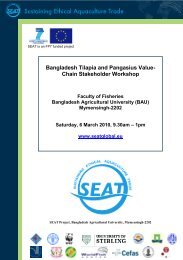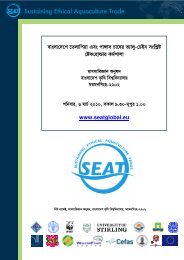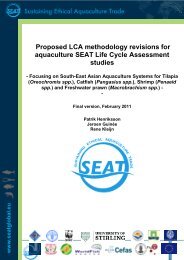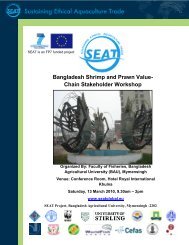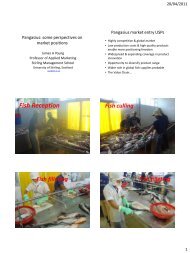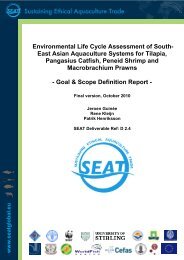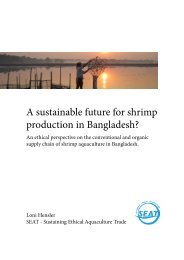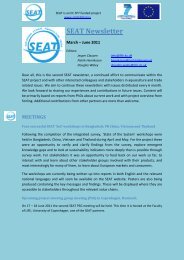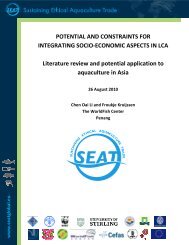English - SEAT Global
English - SEAT Global
English - SEAT Global
You also want an ePaper? Increase the reach of your titles
YUMPU automatically turns print PDFs into web optimized ePapers that Google loves.
- Support to farmers through a certified good aquaculture practices (GAP) scheme is<br />
required to support any traceability scheme – but the Govt. has little capacity to<br />
support this. However, it was felt this should be easier to achieve than a shrimp<br />
certification scheme.<br />
- Only larger farms are likely to achieve necessary export standards<br />
- Producer organizations are weak or absent – the only exception was when a group of<br />
farmers came together to fight land taxes.<br />
Opportunities<br />
- Shrimp processors are currently working at 20% or less of their capacity (they<br />
currently enjoy a 10-15% export subsidy) so pangasius could be a good<br />
diversification strategy.<br />
- Processing would generate substantial by-product (40-45% of weight) and<br />
opportunities for recycling (fish meal etc).<br />
- Promote yellow-flesh colour as a differentiation strategy?<br />
- As only 3-4 countries are currently exporting pangasius, it was felt to have greater<br />
potential than tilapia (c.f. Chinese production).<br />
- Greater water exchange (drainage) capacity in upland areas – could help ameliorate<br />
off-flavour problems.<br />
- Low cost and availability of labour<br />
Group 4: Large-scale farmers and hatcheries<br />
Presented by: M. Mahfujul Haque (Ripon – Assoc. Prof. FoF, BAU)<br />
Constraints<br />
- Low water exchange rates and rapid sludge build-up<br />
- Poor feed quality and high price of feed<br />
- Poor marketing infrastructure for large production volumes<br />
- Feed and seed quality should be regulated by Govt. agencies<br />
- Inbreeding/ cross breeding problem<br />
- High energy costs and increasing<br />
- Disease problems increasing – but no medicine development<br />
Opportunities<br />
- Hatcheries independently trying to improve seed quality based on good private sector<br />
knowledge<br />
- Technical improvements over last 5 years e.g. effective sludge pumps<br />
- Seed and feed quality have decreased while prices have increased<br />
14



